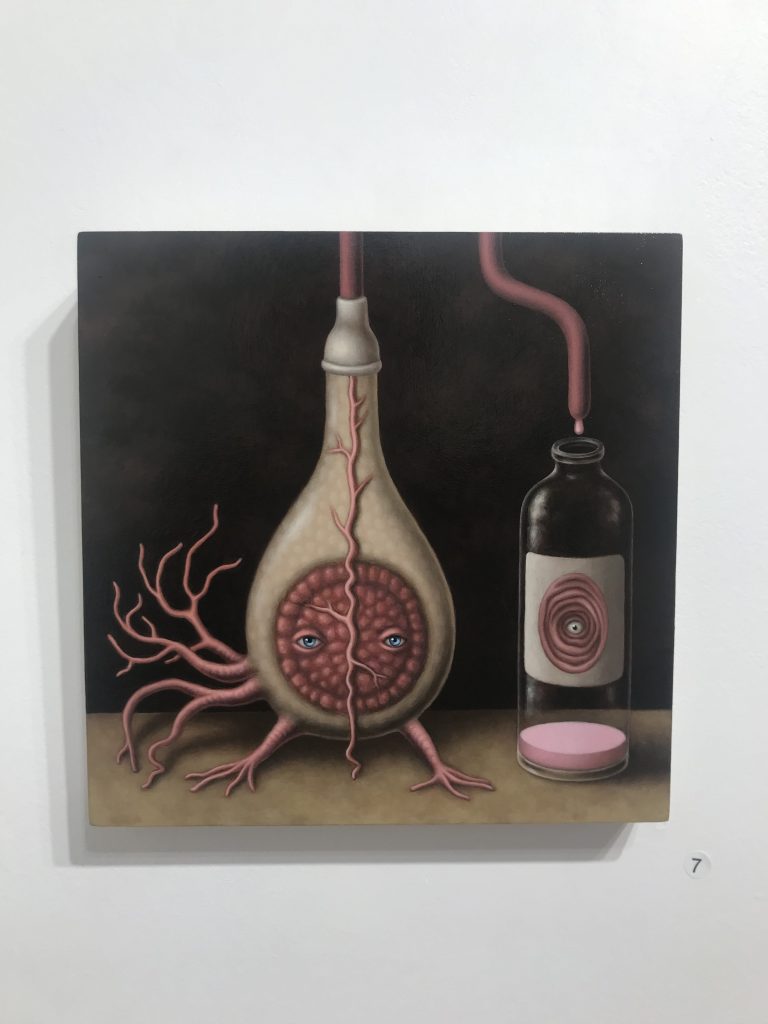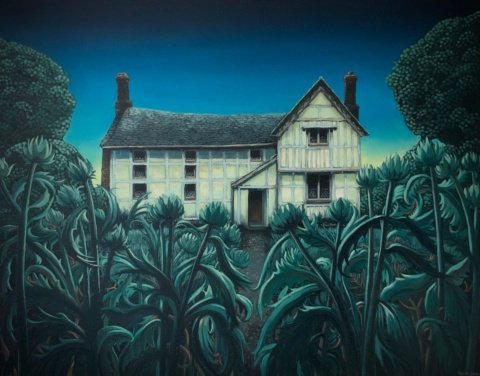Artistic collaborations are wonderful – when two artists produce a work together, they automatically inherit each other’s fanbases. Accordingly, I discovered Australian First Nations singer Alice Skye when she sang on Midnight Oil’s track ‘Terror Australia‘, I found Melburnian band Hiatus Kaiyote when US artist Lauren YS, aka Squidlicker, contributed to their live set design and my introduction to LA-based artist Adrian Cox, one of the four artists at Beinart’s current exhibition, was when he did a tour poster for US prog metal band Tool.
If you’re a newcomer to this specifically surrealist art gallery, just off Sydney Road in the inner Melbourne suburb of Brunswick, this is a five-star review because everything about this place is world class. The owner, Jon Beinart, packs his gallery with the crème de la crème of the surrealist art world, Australian and global. Local examples include next month’s Graeme Base exhibition (creator of the internationally bestselling children’s book Animalia) and the Gallery’s regular displays of Shaun Tan’s art, author of the wordless classic The Arrival, and The Lost Thing, which became an animated short film, winning an Oscar in 2011.
Adrian Cox’s artworks are exercises in world-building, as he creates beings, characters and stories within a world that he calls the Borderlands. This current show, The Labyrinth of Unknowing, shows a chapter of the Borderland’s story that focuses on a Border creature called Maker.
Cox’s use of colour is sharp and visceral, often using and emphasising lighting provided by sunrises, sunsets and moonscapes, as well as the auras projected by the different inhabitants in the Borderlands. This lighting helps create images, which are often simplistic in composition, but grandiose in technique.
An exquisite example is The Great Seamstress’s Wheel, presenting the symbolic, circular relationship between his characters in a reasonably straightforward way, but Cox’s visual imagination, mixed with his stunningly meticulous and precise skills with a brush – which can only really be seen by looking at the physical paintings themselves – show an artist of truly international calibre.
Sydney-based Catronia Secker’s exhibition, entitled Artificial Subconsciousness, is conceptually fascinating, as it involves Artificial Intelligence (AI), something which makes many “traditional” artists recoil. However, what she is saying with this technological tool is unique, because she merges her own art’s concepts of ‘consciousness, connections, and the evolution present in nature’ (presumably meaning that evolution hasn’t finished), with the evolution of AI.
In other words, the mutated images that AI has given her artworks are analogous to the occasionally serendipitous mutations in nature that are the backbone of natural selection. And, as AI has evolved rapidly over the last few years, becoming more skilled, accurate and predictable, its ability to create ‘unexpected, surreal images from this artificial subconsciousness has diminished’.
The resulting artworks, brilliantly-executed paintings, drawings and felt wool sculptures of organisms probably similar to those in Earth’s primordial oceans, are given a new context with the idea that these are possibly the last unpredictable mutations of AI. If techno-anthropology exists, then Secker’s artworks may well appear in a future textbook.

A similarity between Cox and Secker’s art, intended or accurate or not, is that they both discuss universal, spiritual, moral and epistemological notions of what life is, and the directions in which they are travelling. The works of the other two artists, Melbourne-based Molly Melican, better known as Ginklet, and Katie Gamb, from Wisconsin, US, both deal with life more or less as it is now.
Ginklet’s exhibition, Ginklet’s World, is a collection of ceramic sculptures of goblins, “balaclava bandits” and miscellaneous monsters, covered in devil’s horns, spiked necklaces and lipstick, with their grotesqueness, cuteness and pop sensibilities all paradoxically turned up to eleven. Her imagination is wonderfully idiosyncratic, and her sculpting techniques are exceptional.
As Ginklet’s biography states, her works ‘elicit a sense of child-like curiosity’, which very much mirrors the work of Gamb, who has created a series of works involving ‘innocence and nostalgia, juxtaposed with an emerging sense of dread and futility’. Examples are Endless Loop and The Sin Eater, both with the artistic sense of Alice in Wonderland or a travelling circus, but with a barely-hidden sense of loss of innocence and control. Her large-eyed, child-like characters echo those of another artist whose work has graced Beinart, fellow American Thomas Ascott.
Read: Book review: Dirt Poor Islanders, Winnie Dunn
Check out Beinart’s gift shop, featuring Tan, Base and Cox prints and books, and more international names, such as Chet Zar and Masao Kinoshita. If you want to find surrealist art of a truly global standard in Melbourne, Beinart is it. In fact, I daresay there’d be no equivalent anywhere in Australia.
Adrian Cox – The Labyrinth of Unknowing, Catronia Secker – Artificial Subconscious, Ginklet – Ginklet’s World and Katie Gamb – Misfit Toys will be on display until 19 May 2024 at Beinart Gallery.

